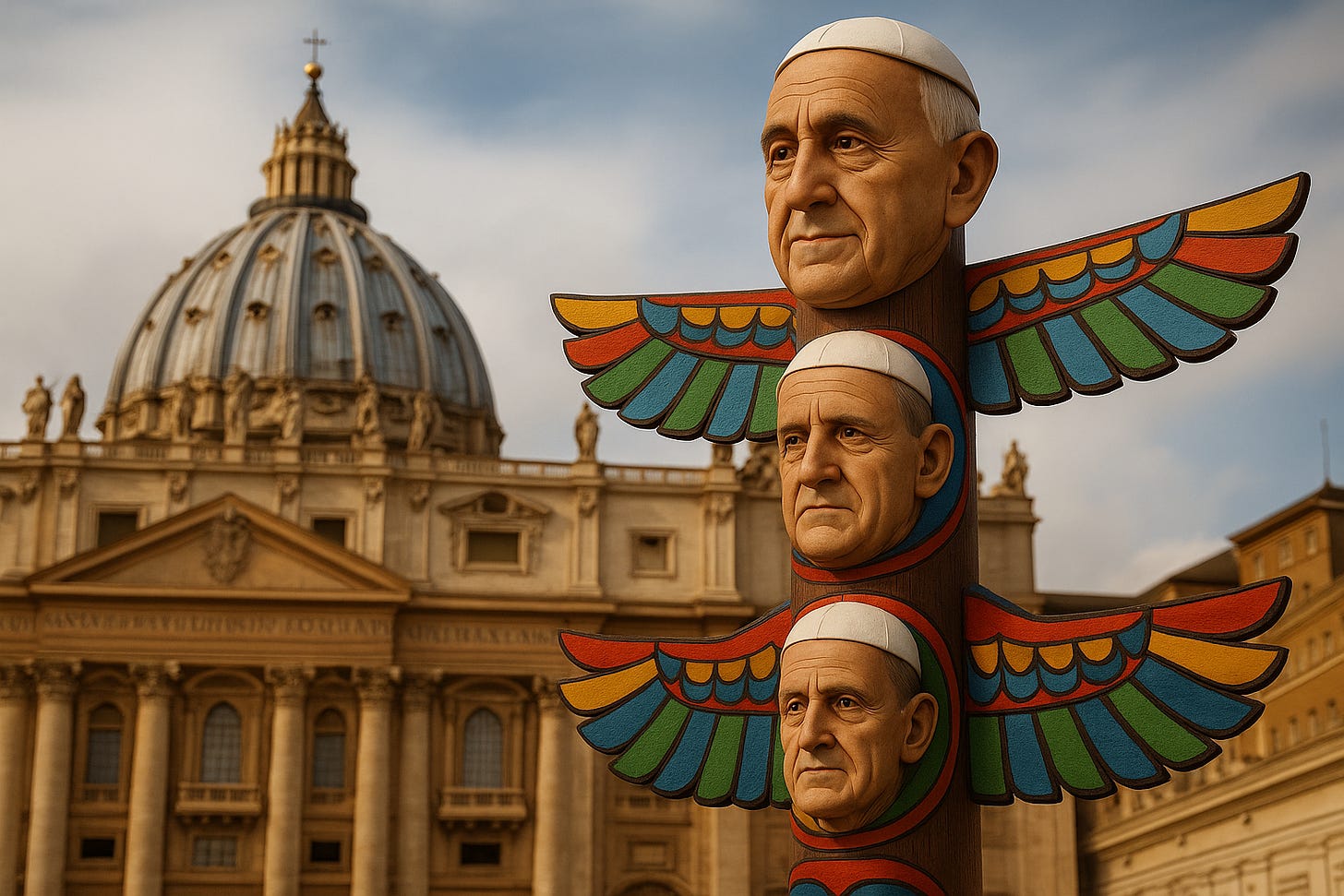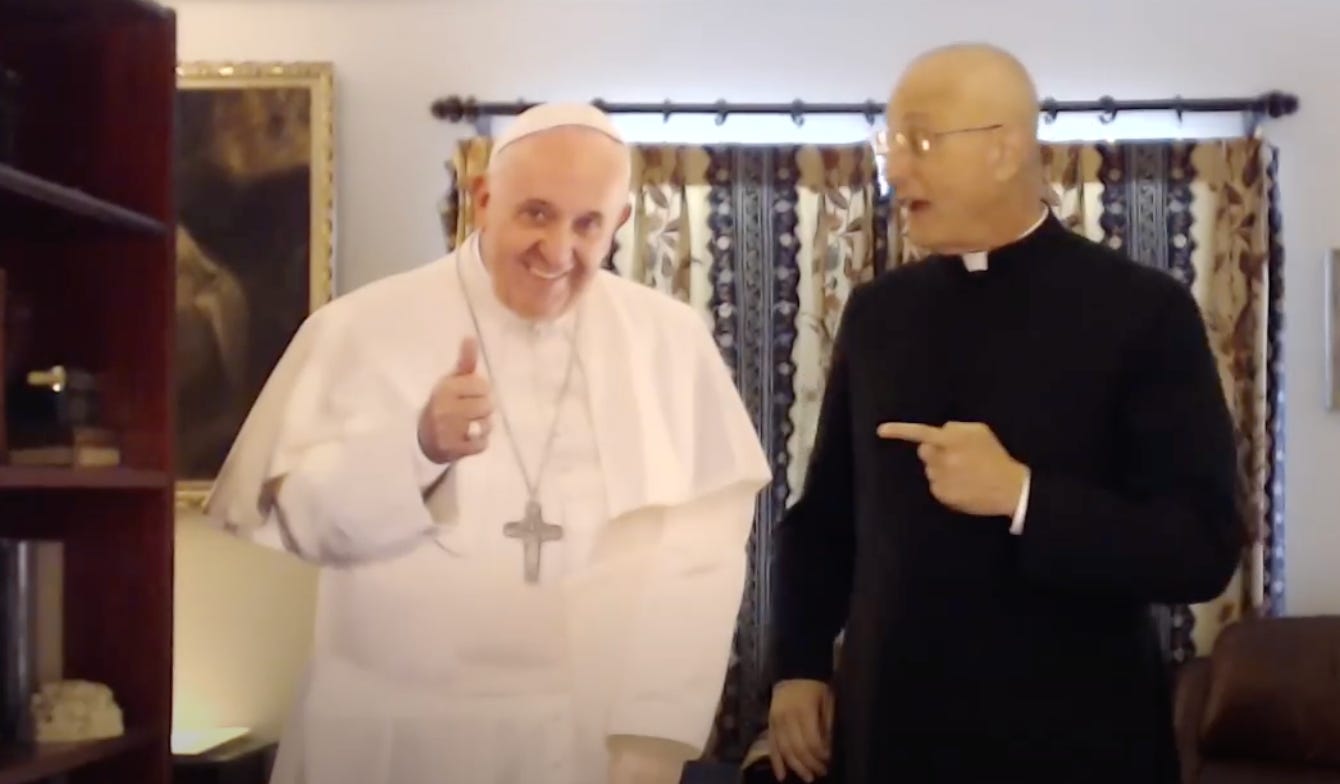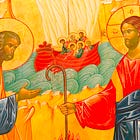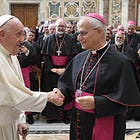'Totem Pope'—Does the mere election of a pope fulfil Christ’s promises?
Christ promised his Church a perpetual succession of divinely protected teachers and rulers. Our current situation has led some to reimagine what this promise really means.

Christ promised his Church a perpetual succession of divinely protected teachers and rulers. Our current situation has led some to reimagine what this promise really means.
TOTEM POPE
Objection: Interest in what Leo XIV (or any Pope) believes and says is misplaced. Following a conclave, the most important thing is that we have a new pope: this fact alone means that the promises of Christ have been fulfilled.
Christ’s promises and his institution of the papacy were by no means limited to the mere presence of a man in Rome who claims this title.
The idea in this objection—that the election of a new pope means that “Christ’s promises have been fulfilled”—also suggests that each time the Roman Pontiff dies, the fulfilment of Christ’s promises is called into question, only to be vindicated at the moment the conclave elects a new Pope.
But to address the assumptions behind this objection, we must examine exactly what Christ promised to Peter.
See Part II here:
What did Christ promise to St Peter?
Christ made several promises to St Peter. These promises include:
That he would build his Church on St Peter (Matthew 16.18)
That the Gates of Hell shall not prevail against it (Matthew 16.18)
That he would give him the keys of the kingdom of heaven, such that what he binds and looses on earth is bound and loosed in heaven (Matthew 16.19)
That Peter’s faith would not fail (Luke 22.32)
Christ fulfilled his promise of the primacy after the Resurrection (John 21).
In the same period, he also promised St Peter and the Apostles:
“I am with you all days, even to the consummation of the world.” (Matthew 28.20).
Holy Scripture does not record Christ directly promising that St Peter would have perpetual successors in the primacy. The perpetual succession is a divinely revealed dogma. While it is implied, contained and entailed in the other promises mentioned, and while we may piously believe that Christ did indeed promise it explicitly, we can note that Vatican I says that this perpetual succession was instituted by Christ, rather than promised.
With these promises expressed, let us return to the promises which are included in Sacred Scripture, and examine the two parts of Our Lord’s promise:
That the Gates of Hell…
… shall not prevail
The Gates of Hell…
It may be suggested that the mere election of a new pope is what is meant by the Gates of Hell not prevailing. This is radically insufficient, if not false.
Cornelius a Lapide explains that the phrase the Gates of Hell refers to heresies and heresiarchs:
The gates of hell, i.e., the infernal city, meaning all hell, with its entire army of demons, and with the whole power of Lucifer its king. For hell and the city of God, i.e., the Church, are here put in opposition.
When S. Augustine wrote his work de Civitate Dei, in the beginning of which he speaks of the two opposite cities; the one of God which is the Church; the other of the devil, i.e., of demons and wicked men: he takes the gates of hell to mean heresies, and heresiarchs; for they fight against the faith of Peter and the Church, and they proceed from hell and are stirred up by the devil. So S. Epiphanius (in Ancoratu), not far from the beginning.1
… shall not prevail
A Lapide continues:
Shall not prevail. Heb. lo juchelu la, i.e., shall not be able to stand against it—namely, the Church. So S. Hilary and Maldonatus.
More simply, shall not prevail, i.e., shall not conquer or overcome, or pull down the Church. For this is the meaning of the original Greek. We have here the figure of speech, miosis: for little is said but much is meant; not only that the Church shall not be conquered, but that she shall conquer and subdue under her all heretics, tyrants, and every other enemy, as she overcame Arians, Nestorians, Pelagians, Nero, Decius, Diocletian, &c. Therefore by this word Christ first animates his Church that she should not be faint hearted when she sees herself attacked by all the power of Satan and wicked men.
In the second place, He as it were sounds a trumpet for her, that she may always watch with her armour on against so many enemies, who attack her with extreme hatred.
Thirdly, He promises to her, as well as to her head, Peter, i.e., the Pontiff—victory and triumph over them all. Again, Christ and the Holy Ghost assist with special guidance her head, the Roman Pontiff, that he should not err in matters of faith, but that he may be firm as an adamant, says S. Chrysostom, and that he may rightly administer and rule the Church, and guide it in the path of safety, as Noah also directed the ark that it should not be overwhelmed in the deluge.2
There is no sense here that what Our Lord promised was the mere existence of a man sitting on the Holy See—whether enjoying legitimate succession, or “a mere temporal continuation of one person after another” (material succession).3
The succession exists for a purpose beyond itself.
Indefectibility promised
Christ’s promises to St Peter pertain directly to the indefectibility of the Church.
In addition to promising that the Gates of Hell will not prevail against the Church, he also promised St Peter at the Last Supper “I have prayed for thee, that thy faith fail not” (Luke 22.32). Vatican I teaches that the “gift of truth and never-failing faith” promised to St Peter was also conferred on his successors, and clarifies why Christ bestowed it:
This gift of truth and never-failing faith was therefore divinely conferred on Peter and his successors in this see so that they might discharge their exalted office for the salvation of all, and so that the whole flock of Christ might be kept away by them from the poisonous food of error and be nourished with the sustenance of heavenly doctrine.
Thus the tendency to schism is removed and the whole church is preserved in unity, and, resting on its foundation, can stand firm against the gates of hell.4
Vatican I also teaches that these gifts were given to St Peter so that he and his successors could preserve and promote the two unities of the Church—that of faith and of communion (external, social charity).
In order, then, that the episcopal office should be one and undivided and that, by the union of the clergy, the whole multitude of believers should be held together in the unity of faith and communion, he set blessed Peter over the rest of the apostles and instituted in him the permanent principle of both unities and their visible foundation.5
This is why Pope Leo XIII rejects the idea of the Roman Pontiff as a mere figurehead, enjoying a “primacy of honour,” and refers to the Chair of St Peter as the efficient cause of unity:
It is consequently the office of St. Peter to support the Church, and to guard it in all its strength and indestructible unity. How could he fulfil this office without the power of commanding, forbidding, and judging, which is properly called jurisdiction? It is only by this power of jurisdiction that nations and commonwealths are held together. A primacy of honour and the shadowy right of giving advice and admonition, which is called direction, could never secure to any society of men unity or strength…
The meaning of this divine utterance [“the Gates of Hell, etc.”] is, that, notwithstanding the wiles and intrigues which they bring to bear against the Church, it can never be that the church committed to the care of Peter shall succumb or in any wise fail. […]
[St Cyprian] calls [the Roman Church] the principal Church, on account of the primacy conferred on Peter himself and his legitimate successors; and the source of unity, because the Roman Church is the efficient cause of unity in the Christian commonwealth.6
There may be a sense in which both Pope and See can be said to bring about the unity of the Church by their mere existence, insofar as the entire Catholic world submits to the legitimate authority of a reigning Roman Pontiff, and adheres to all the teaching and laws which he implicitly and tacitly promulgates.
However, in the absence of explicit teaching and governance, this unity will quickly erode, and Catholics will find themselves falling away into either heresy or schism. Romano Amerio noted this very phenomenon in the post-conciliar epoch:
The external fact is the disunity of the Church, visible in the disunity of the bishops among themselves, and with the Pope. […] The internal fact producing [this disunity] is the renunciation that is, the non-functioning, of papal authority itself, from which the renunciation of all other authority derives.7
For this reason, the proper sense in which the Chair of St Peter is the efficient cause of unity is through the Roman Pontiff’s discharge of the duties discussed above. As Vatican I taught, these duties primarily include:
The protection of Christians from “the poisonous food of error,” and their nourishment “with the sustenance of heavenly doctrine”
The removal of “the tendency to schism” and the preservation of the whole Church in unity.
In other words, Christ did not just promise a set of prerogatives (or a mere perpetual succession) for the sake of it, but so that St Peter and his successors could preserve the unities of faith and charity through discharging the duties of the papal office.
The Roman Pontiff discharges these duties through the teaching and governing the universal Church, as Pope Leo XIII expressed above.
Teaching and Governing as human acts
Teaching and governing are both human acts. A human act may be defined as one which “proceeds from an internal principle, the will, with an intellectual knowledge of the end of the action.”8
Thus we see immediately that Christ’s promises are fulfilled, and the unity of faith and charity achieved, through the Roman Pontiff freely and consciously exercising his authority—all the time guided “strongly and sweetly” by the divine protection. The exercise of this authority results in teachings and laws which are rational and intelligible, and must be apprehended by our reason and will if they are to be of any purpose.
Pope Pius IX did not teach that the unity of the Church would be achieved by the mere existence of a living Roman Pontiff, but by the faithful reception and obedience to the legitimate teaching and governing authority of the Roman Pontiff, exercised not just implicitly and tacitly, but also explicitly. He writes:
Indeed one simple way to keep men professing Catholic truth is to maintain their communion with and obedience to the Roman Pontiff. For it is impossible for a man ever to reject any portion of the Catholic faith without abandoning the authority of the Roman Church.
In this authority, the unalterable teaching office of this faith lives on. It was set up by the divine Redeemer and, consequently, the tradition from the Apostles has always been preserved.9
In other words, one cannot enjoy the benefits of Christ instituting the papacy unless we pay attention to the teaching and governing authority of the reigning Roman Pontiff.
One might suggest that this teaching and governance is mediated to us through the diocesan bishop, and the parish priest whom he appoints over our geographical area. This would, however, be a most incongruous argument if made by anyone attending an “irregular” Mass centre.
Should we ignore what is going on in Rome?
Further, in our current age, one cannot afford to ignore what is happening in Rome, or pretend nothing is happening there. We have been “on notice” that evil is afoot, and we are more or less obliged to understand what is happening so that we can act accordingly. St Robert Bellarmine taught the following:
I respond that the people indeed ought to discern the true prophet from the false, but by no other rule than by carefully attending to whether the one who preaches says things contrary to those taught by his predecessors, or to those taught by other lawful pastors, and especially by the Apostolic See and the principal Church; for the people are commanded to listen to their own pastors: Luke 10: “He that heareth you, heareth me.” And Matthew 23: “What they say, do” (Luke 10:16, Matthew 23:3).
Therefore, the people should not judge their pastor unless they hear something new and contrary to the doctrine of other pastors.
Furthermore, this is what Paul advises in Galatians 1: that we should anathematise those who teach new doctrines that are contrary to what has been preached before.
Moreover, since the people are unlearned, they cannot otherwise judge the doctrine of their pastor.10
One cannot judge that which one ignores.
It is also important for the sake of warning others, regardless of what one thinks of the legitimacy of the recent papal claimants.
This is certainly not to say that everyone should maintain a perpetual focus on Rome, still less that this is a foundation for our faith: it is not.
But just as it behoves us to keep an eye on the weather and to act accordingly, the same applies to Rome.
What this means for the ‘Totem Pope’
When Christ called St Peter “this rock,” he described the firmness and solidity of his Apostle, and promised to augment this firmness with his own divine grace. Our Lord’s primary point was not to compare St Peter with an inanimate object, or suggesting that the divine assistance he would impart might as well have been imparted to a rock.
He did not promise simply that there would always be a man in white sitting on the See of St Peter—but rather, that he would be perpetually “with” the legitimate successors of St Peter, guiding the Church strongly and sweetly, through the exercise of their teaching, governing and sanctifying authority.
Once we grasp the true nature of Christ’s promises to St Peter, and the purpose for which they were given, we can see that an interregnum—however long—could not possibly call these promises into question, any more than the mere election of a new pope could verify them.
Such an understanding of these promises would reduce the Roman Pontiff to the level of a divinely-charged rock, or even a totem pole—lesser even than the mythical “Bronze Head” some have satirically claimed Suarez would have accepted as pope.11 At least the Bronze Head was purported to speak intelligible propositions!
This notion—redolent of pagan fetishism and not unlike Father Anthony Cekada’s image of the “cardboard pope”—attributes to the mere existence of the charmed “Totem Pope” what Catholic theology attributes to the divinely protected exercise of the papal office.
This understanding is, in short, wholly superstitious.

The ideology of the Totem Pope creates a framework which allows its adherents to embrace other strange ideas. These ideas include:
The unity of the Church in her faith and communion are conflated, and reduced to a mere outward agreement on the identity of the pope
The Church is made up of wings or factions, including a “conservative” or “high church” wing an a “liberal” or “modernist” wing, differentiated not by political outlooks but by doctrinal adherence
Open heretics remain members of the Church
Open heretics and those who openly teach and govern in ways incompatible with the Catholic Faith retain offices within her
It is “un-Catholic” to pay attention to what happens in Rome, or to care whether the Pope is a “liberal”—by which is meant, a doctrinal liberal
A long interregnum is impossible.
These topics will be addressed elsewhere. In the meantime, let us reaffirm that Our Lord established in his Church a supreme teacher and governor, and the superstitious idea of the Totem Pope leads to a redefinition of the Church’s visible unity of faith and government—and the embrace of something not too different from that of the “Synodal Pope” itself.
On the contrary, both the actual unity in faith as taught and professed and the actual communion of social charity are effected by the divinely protected supreme teacher and governor; they cannot be effected by the charmed existence of a Totem Pope; and to claim that achieving an unity about the identity of the Totem Pope is the fruit and raison d’être of Christ’s promises to St Peter is risible.
Conclusion: What would call these promises into question
We started by considering the exact nature of Christ's promises, and demonstrated that they are neither fulfilled by an election of a new Pope, not called into question by during an interregnum—whether short or long.
However, what would call Christ’s promises into question—per impossibile—would be the withdrawal of the divine protection, such that a true pope (or series of true popes) begin teaching errors and promulgating evil laws—or, worse still, offering a new and false religion to the Church.
However, the problem that faces us today is that those three “anti-verifications”—the teaching of errors, the promulgation of evil laws, and the offering of a new and false religion—are precisely what the papal claimants since Paul VI have done.
What is the solution? We cannot, of course, say that Christ’s promises have failed. Therefore, the current situation leaves us with a choice.
Do we invent a new theology and redefine Christ’s promises accordingly, so as to fit our interpretation of events?
Or do we look deeper, beyond superficial elements such as white cassocks (or even red mozettas) and reevaluate our interpretation of events?
While it is impossible for a true Roman Pontiff to do what Paul VI and his successors have done, it is not impossible that the Church may be chastised with an extended interregnum and usurpation of the Holy See by a series of antipopes—which, if it were to be the case, would look precisely like the current crisis in the Church.
See Totem Pope II here:
HELP KEEP THE WM REVIEW ONLINE WITH WM+!
As we expand The WM Review we would like to keep providing free articles for everyone.
Our work takes a lot of time and effort to produce. If you have benefitted from it please do consider supporting us financially.
A subscription gets you access to our exclusive WM+ material, and helps ensure that we can keep writing and sharing free material for all.
(We make our WM+ material freely available to clergy, priests and seminarians upon request. Please subscribe and reply to the email if this applies to you.)
Subscribe to WM+ now to make sure you always receive our material. Thank you!
Read Next:
Follow on Twitter, YouTube and Telegram:
He continues:
There are here the two figures of speech—synecdoche and metonymy; for by the gates he means the whole city, both because the gate is the entrance into a city, and because the chief defences and strength of a city are wont to be at the gates, because if they and the adjoining walls are safe, the city is safe, if they are taken, the city is taken.
Cornelius à Lapide, The Great Commentary, St Matthew’s Gospel, Vol II (Chaps. X to XXI), pp 222. John Hodges, Covent Garden London, Third Edition, 1889.
He continues:
Wherefore S. Chrysostom (Hom. de Verb. Isaiah) says: “It were more easy for the sun to be extinguished than for the Church to fail;” and again, “what can be more powerful than the Church of God: the barbarians destroy fortifications, but not even the devils overcome the Church. When it is attacked openly, it conquers; when it is attacked by treachery, it overcomes.”
S. Augustine on the Psalms against the Donatists, says: “Reckon up the Bishops even from the very Pontificate of Peter. That is the very rock which the proud gates of hell conquer not.” This has been made especially plain in the conversion of all nations, specially of Rome and the Romans. For Rome being the head, both of the world and of idolatry, where the idols of all nations were worshipped, has been converted from them by S. Peter and his successors, and has bowed down her proud head to the cross of Christ, which thing is of all miracles the greatest.
Ibid., 222-3.
Joachim Salaverri, ‘On the Church of Christ,’ in Sacrae Theologia Summa IB trans. Kenneth Baker SJ , Keep the Faith, 2015, n 334.
Vatican I, Pastor Aeternus, Session IV, 18 July 1870. Ch. 4, n. 7.
Ibid., Preamble n. 4.
Pope Leo XIII, Satis Cognitum nn. 12, 13.
Romano Amerio, Iota Unum – A study of the changes in the Catholic Church in the XXth century, Sarto House, Kansas City MO, 1996. 143.
‘On Human Acts’ by Rev. John A. Driscoll OP, in St Thomas Aquinas, Summa Theologica, First Complete American Edition in Three Volumes, trans. Fathers of the English Dominican Province. Vol. III, Benziger Brothers, Inc., New York, 1948 pp 3201-3220. Available here:
Pope Pius IX, Nostis et Nobiscum, 1849, n. 17.
St Robert Bellarmine, Fifth Controversy: The Members of the Church – On the Clergy, Book I, Chapter VII. Available from Google Books and in translation here.
Suarez wrote:
To the third confirmation it is responded in one word, that a heretical Pope is not a member of the Church, in regard to substance and form whereby they are constituted members of the Church, still he can be the head in regard to office and influence. This should not be marveled at, because God does not influence the first and special head by his virtue, but just as instrumentally and the vicar of the first head [Christ], because he is capable of giving spiritual influence to the members, just as through the bronze head; for a proportional reason sometimes he baptizes through heretics, sometimes he even absolves through them, as it was said.
https://athanasiuscm.org/2015/05/11/suarez-on-what-to-do-if-the-pope-falls-into-heresy/







This article is very thorough and deals comprehensively with the argument advanced by those of the R&R camp, that 1. There always has to be somebody sitting on the chair of Peter, even if they are public heretics. 2. That the promises of our Lord to St. Peter are somehow fulfilled by such a "Pope". Excellent job per usual.
Came for the headline stayed for the ride. Quite the education here. Well done.